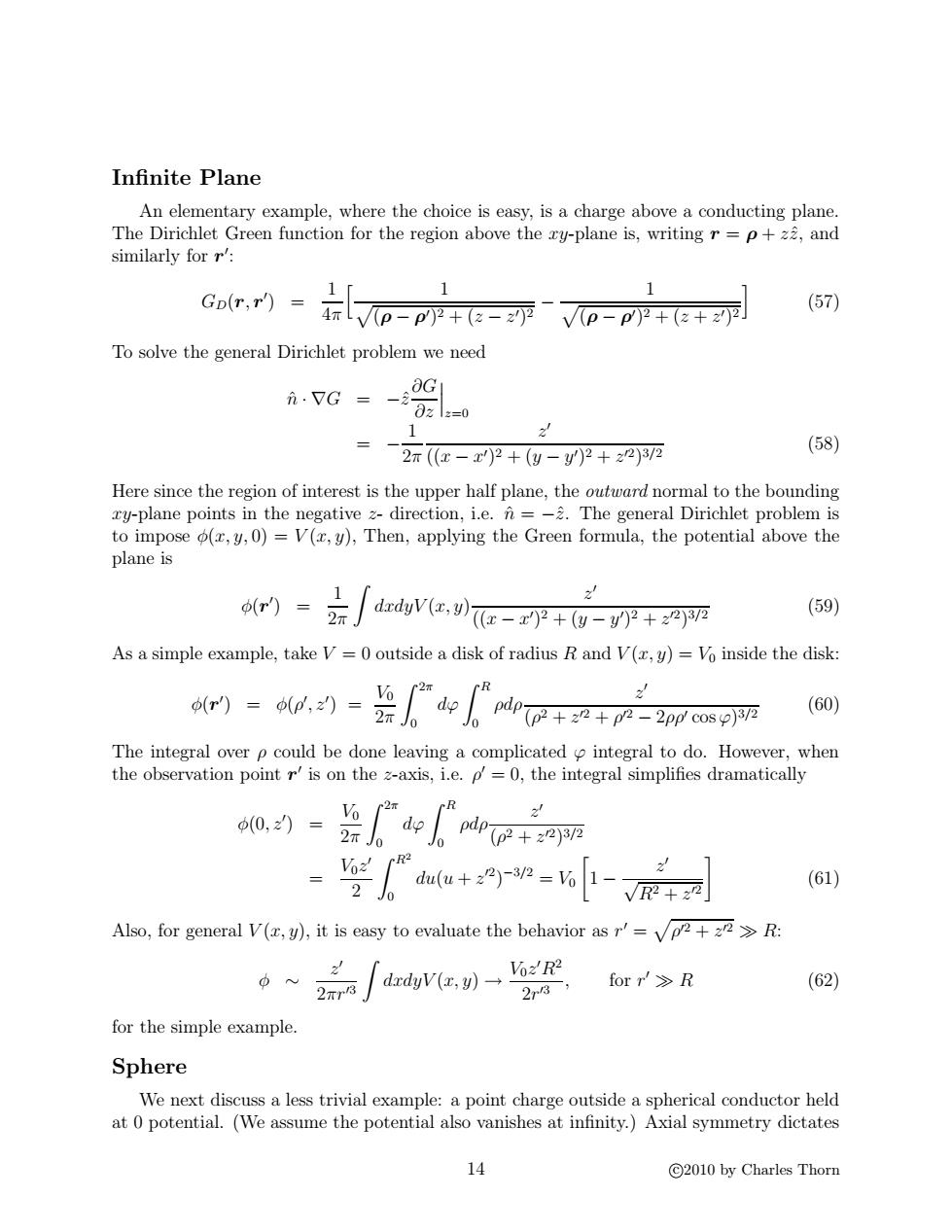正在加载图片...

Infinite Plane An elementary example,where the choice is easy,is a charge above a conducting plane. The Dirichlet Green function for the region above the xy-plane is,writing r=p+22,and similarly for r': 1 GD(r,) 1 4玩 p-p)2+(a-2元-√p-pP+z+元 (57) To solve the general Dirichlet problem we need i.7G=- 、aG 0z1z=0 1 2m(c-x')2+(y-)2+z2)3/2 (58) Here since the region of interest is the upper half plane,the outward normal to the bounding xy-plane points in the negative z-direction,i.e.n=-2.The general Dirichlet problem is to impose o(x,y,0)=V(r,y),Then,applying the Green formula,the potential above the plane is (r)= ddwV(,纱c-rP+g-P+2丽 (59) As a simple example,take V=0 outside a disk of radius R and V(,y)=Vo inside the disk: (r')=(p,)= 2元0 pdp2pp co (60) The integral over p could be done leaving a complicated integral to do.However,when the observation point r'is on the z-axis,i.e.p'=0,the integral simplifies dramatically 60,0= 62m R 2元J0 %r du(u+z2)-32=61 2 2+元 (61) Also,for general V(r,y),it is easy to evaluate the behavior as r'=vp2+2R: Voz'R2 forrR 2Tr3 dxdyV(x,y)→ 28, (62) for the simple example. Sphere We next discuss a less trivial example:a point charge outside a spherical conductor held at 0 potential.(We assume the potential also vanishes at infinity.)Axial symmetry dictates 14 ©2010 by Charles ThornInfinite Plane An elementary example, where the choice is easy, is a charge above a conducting plane. The Dirichlet Green function for the region above the xy-plane is, writing r = ρ + zzˆ, and similarly for r 0 : GD(r, r 0 ) = 1 4π h 1 p (ρ − ρ0 ) 2 + (z − z 0 ) 2 − 1 p (ρ − ρ0 ) 2 + (z + z 0 ) 2 i (57) To solve the general Dirichlet problem we need nˆ · ∇G = −zˆ ∂G ∂z
z=0 = − 1 2π z 0 ((x − x 0 ) 2 + (y − y 0 ) 2 + z 02 ) 3/2 (58) Here since the region of interest is the upper half plane, the outward normal to the bounding xy-plane points in the negative z- direction, i.e. nˆ = −zˆ. The general Dirichlet problem is to impose φ(x, y, 0) = V (x, y), Then, applying the Green formula, the potential above the plane is φ(r 0 ) = 1 2π Z dxdyV (x, y) z 0 ((x − x 0) 2 + (y − y 0) 2 + z 02) 3/2 (59) As a simple example, take V = 0 outside a disk of radius R and V (x, y) = V0 inside the disk: φ(r 0 ) = φ(ρ 0 , z 0 ) = V0 2π Z 2π 0 dϕ Z R 0 ρdρ z 0 (ρ 2 + z 02 + ρ 02 − 2ρρ0 cos ϕ) 3/2 (60) The integral over ρ could be done leaving a complicated ϕ integral to do. However, when the observation point r 0 is on the z-axis, i.e. ρ 0 = 0, the integral simplifies dramatically φ(0, z 0 ) = V0 2π Z 2π 0 dϕ Z R 0 ρdρ z 0 (ρ 2 + z 02) 3/2 = V0z 0 2 Z R2 0 du(u + z 02 ) −3/2 = V0 1 − z 0 √ R2 + z 02 (61) Also, for general V (x, y), it is easy to evaluate the behavior as r 0 = p ρ 02 + z 02
R: φ ∼ z 0 2πr 03 Z dxdyV (x, y) → V0z 0R2 2r 03 , for r 0
R (62) for the simple example. Sphere We next discuss a less trivial example: a point charge outside a spherical conductor held at 0 potential. (We assume the potential also vanishes at infinity.) Axial symmetry dictates 14 c 2010 by Charles Thorn